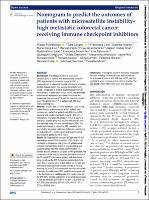| dc.contributor | Vall d'Hebron Barcelona Hospital Campus |
| dc.contributor.author | Corti, Francesca |
| dc.contributor.author | Infante, Gabriele |
| dc.contributor.author | Elez Fernandez, Mª Elena |
| dc.contributor.author | Ros Montañá, Fco. Javier |
| dc.contributor.author | Fakih, Marwan |
| dc.contributor.author | Pietrantonio, Filippo |
| dc.contributor.author | Lonardi, Sara |
| dc.date.accessioned | 2022-04-22T13:01:39Z |
| dc.date.available | 2022-04-22T13:01:39Z |
| dc.date.issued | 2021-08 |
| dc.identifier.citation | Pietrantonio F, Lonardi S, Corti F, Infante G, Elez ME, Fakih M, et al. Nomogram to predict the outcomes of patients with microsatellite instability-high metastatic colorectal cancer receiving immune checkpoint inhibitors. J Immunother Cancer. 2021 Aug;9(8):e003370. |
| dc.identifier.issn | 2051-1426 |
| dc.identifier.uri | https://hdl.handle.net/11351/7373 |
| dc.description | Gastrointestinal neoplasms; Immunotherapy |
| dc.description.abstract | Background The efficacy of immune checkpoint inhibitors (ICIs) in patients with microsatellite instability (MSI)-high metastatic colorectal cancer (mCRC) is unprecedented. A relevant proportion of subjects achieving durable disease control may be considered potentially ‘cured’, as opposed to patients experiencing primary ICI refractoriness or short-term clinical benefit. We developed and externally validated a nomogram to estimate the progression-free survival (PFS) and the time-independent event-free probability (EFP) in patients with MSI-high mCRC receiving ICIs.
Methods The PFS and EFP were estimated using a cure model fitted on a developing set of 163 patients and validated on a set of 146 patients with MSI-high mCRC receiving anti-programmed death (ligand)1 (PD-(L)1) ± anticytotoxic T-lymphocyte antigen 4 (CTLA-4) agents. A total of 23 putative prognostic factors were chosen and then selected using a random survival forest (RSF). The model performance in estimating PFS probability was evaluated by assessing calibration (internally—developing set and externally—validating set) and quantifying the discriminative ability (Harrell C index).
Results RFS selected five variables: ICI type (anti-PD-(L)1 monotherapy vs anti-CTLA-4 combo), ECOG PS (0 vs >0), neutrophil-to-lymphocyte ratio (≤3 vs >3), platelet count, and prior treatment lines. As both in the developing and validation series most PFS events occurred within 12 months, this was chosen as cut-point for PFS prediction. The combination of the selected variables allowed estimation of the 12-month PFS (focused on patients with low chance of being cured) and the EFP (focused on patients likely to be event-free at a certain point of their follow-up). ICI type was significantly associated with disease control, as patients receiving the anti-CTLA-4-combination experienced the best outcomes. The calibration of PFS predictions was good both in the developing and validating sets. The median value of the EFP (46%) allowed segregation of two prognostic groups in both the developing (PFS HR=3.73, 95% CI 2.25 to 6.18; p<0.0001) and validating (PFS HR=1.86, 95% CI 1.07 to 3.23; p=0.0269) sets.
Conclusions A nomogram based on five easily assessable variables including ICI treatment was built to estimate the outcomes of patients with MSI-high mCRC, with the potential to assist clinicians in their clinical practice. The web-based system ‘MSI mCRC Cure’ was released. |
| dc.language.iso | eng |
| dc.publisher | BMJ |
| dc.relation.ispartofseries | Journal for ImmunoTherapy of Cancer;9(8) |
| dc.rights | Attribution 4.0 International |
| dc.rights.uri | http://creativecommons.org/licenses/by/4.0/ |
| dc.source | Scientia |
| dc.subject | Recte - Càncer - Tractament |
| dc.subject | Còlon - Càncer - Tractament |
| dc.subject | Nomografia (Matemàtica) |
| dc.subject.mesh | Colorectal Neoplasms |
| dc.subject.mesh | /drug therapy |
| dc.subject.mesh | Nomograms |
| dc.subject.mesh | Microsatellite Instability |
| dc.title | Nomogram to predict the outcomes of patients with microsatellite instability-high metastatic colorectal cancer receiving immune checkpoint inhibitors |
| dc.type | info:eu-repo/semantics/article |
| dc.identifier.doi | 10.1136/jitc-2021-003370 |
| dc.subject.decs | neoplasias colorrectales |
| dc.subject.decs | /farmacoterapia |
| dc.subject.decs | nomogramas |
| dc.subject.decs | inestabilidad de microsatélites |
| dc.relation.publishversion | http://dx.doi.org/10.1136/jitc-2021-003370 |
| dc.type.version | info:eu-repo/semantics/publishedVersion |
| dc.audience | Professionals |
| dc.contributor.organismes | Institut Català de la Salut |
| dc.contributor.authoraffiliation | [Pietrantonio F, Corti F] Department of Medical Oncology, Fondazione IRCCS Istituto Nazionale dei Tumori, Milan, Italy. [Lonardi S] Medical Oncology 3, Istituto Oncologico Veneto IOV-IRCSS, Padua, Italy. [Infante G] Unit of Clinical Epidemiology and Trial Organization, Fondazione IRCCS Istituto Nazionale dei Tumori, Milan, Italy. [Elez ME, Ros J] Servei d’Oncologia Mèdica, Vall d'Hebron Hospital Universitari, Barcelona, Spain. Vall d'Hebron Institute of Oncology (VHIO), Barcelona, Spain. Universitat Autònoma de Barcelona, Bellaterra, Spain. [Fakih M] Department of Medical Oncology, City of Hope Comprehensive Cancer Center, Duarte, California, USA |
| dc.identifier.pmid | 34429334 |
| dc.identifier.wos | 000688528100002 |
| dc.rights.accessrights | info:eu-repo/semantics/openAccess |

